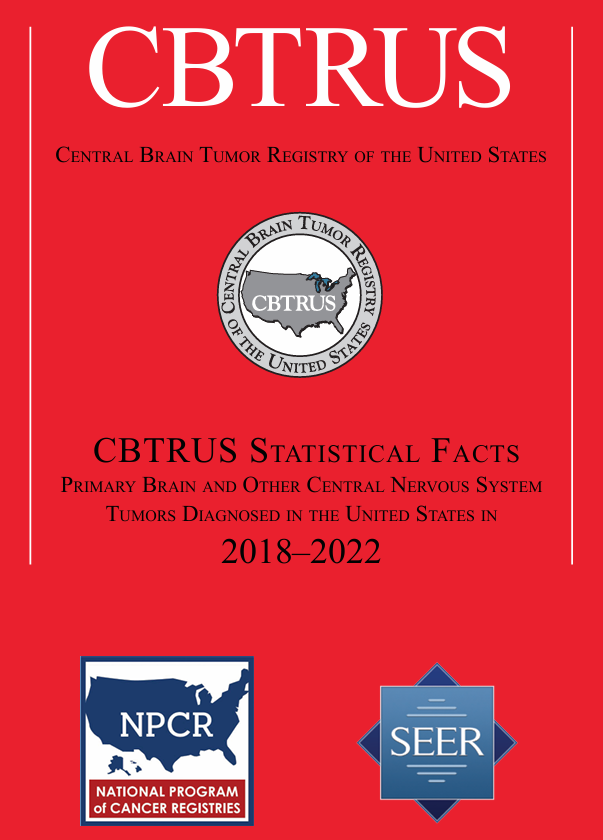Incidence rates in the United States provided by CBTRUS are based on the 2000 US standard population and are reported per 100,000 population for 2018-2022.
The CBTRUS database is comprised of only de-identified data. No patient-identifying information is collected.
Worldwide incidence rates, used for comparison, are from the International Agency for Research on Cancer (IARC), which includes primary malignant tumors of the brain and other CNS (excluding brain lymphoma and leukemia, tumors of the pituitary and pineal glands, and olfactory tumors of the nasal cavity). These global rates are age-adjusted using the world standard population. These rates may be compared to other rates adjusted to the world standard population, but they cannot be compared to rates adjusted to other population standards, such as the 2000 United States standard population.
CBTRUS presents observed and relative survival based on the 43 registries provided by the CDC’s NPCR survival data. This dataset provides population-based information for 87.5% of the United States population for the years 2004 to 2021 and is a subset of the data used for the incidence calculations presented in the 2025 CBTRUS Statistical Report.
The facts provided below are based on the most up-to-date information available (October 2025) and includes almost 100% of the United States population. This information is based on data from 2018-2022.
United States Incidence
- The average annual age-adjusted incidence rate (AAAIR) of all primary malignant and non-malignant brain and other CNS tumors in the US was 26.05 cases per 100,000, for a five-year total count of 489,718 incident tumors; (6.86 per 100,000 for malignant tumors [128,865 cases] and 19.19 per 100,000 for non-malignant tumors [360,853 cases]).¹
- The rate was higher in females (29.67 per 100,000) resulting in 290,703 cases than males (22.23 per 100,000) resulting in 199,015 cases.¹
Global Incidence
- The worldwide incidence rate of primary malignant brain and other CNS tumors in 2022, age-adjusted using the world standard population, was 3.5 per 100,000 population (321,731).²
- Incidence rates by sex were 3.9 per 100,000 males (173,699) and 3.1 per 100,000 females (148,032).²
Pediatric Incidence (Ages 0-14 Years)
- The incidence rate of childhood primary malignant and non-malignant brain and other CNS tumors in the US was 5.51 per 100,000 for a five-year total of 16,831 cases.¹
- The most common histopathology in this age group was Pilocytic astrocytoma with an incidence rate of 1.13 per
100,000.¹
Adolescent & Young Adult (AYA) Incidence (Ages 15-39 Years)
- The incidence rate of AYA primary malignant and non-malignant brain and other CNS tumors in the US was 12.31 cases per 100,000 (67,368).¹
- The rate was higher for non-malignant tumors (9.16 per 100,000) for a total of 50,020 than malignant tumors (3.16 per 100,000) 17,348.¹
- The most common histopathology in this age group was Tumors of the Pituitary with an incidence rate of 4.65 per 100,000.¹
Adult Incidence (Ages 40+ Years)
- The incidence rate of adult primary malignant and non-malignant brain and other CNS tumors in the U S was 47.62 cases per 100,000 population (405,519 cases).¹
- The rate higher for non-malignant tumors (36.02 per 100,000) for a total of 304,604 when compared to malignant tumors (11.60 per 100,000) for a total of 100,915.¹
- The most common histopathology in this age group was Meningioma with an incidence rate of 23.02 per 100,000.¹
Incidence by Race and Hispanic Ethnicity
- Incidence rates for all primary brain and other CNS tumors combined were lower for persons who were non-Hispanic Asian or Pacific Islander (20.42 per 100,000) compared to persons who were non-Hispanic White (26.36 per 100,000), non-Hispanic Black (27.40 per 100,000), non-Hispanic American Indian/Alaska Native (24.38 per 100,000), and Hispanic persons of all races (24.69 per 100,000).¹
- Incidence rates for non-malignant primary brain and other CNS tumors were highest in persons who are non-Hispanic Black (22.93 per 100,000) compared to persons who are non-Hispanic White (18.68 per 100,000), non-Hispanic American Indian/Alaska Native (18.64 per 100,000), non-Hispanic Asian or Pacific Islander (15.39 per 100,000), and Hispanic persons of all races (15.79 per 100,000).¹
Mortality
- The average annual mortality rate in the US between 2018 and 2022 was 4.41 per 100,000 population with 88,186 total deaths attributed to primary malignant brain and other CNS tumors.1,3
- This represents an average of 17,637 deaths per year and 48 deaths per day.1,3
- Among children ages 0-14 years, brain and other CNS tumors are the most common cause of cancer death and the second most significant contributor to cancer death in AYA.1,3
Years of Life Lost Due to Primary Brain and Other CNS Tumors
- In 2018, a total of 379,695 years of expected life were lost due to early death attributed to brain and other CNS tumors.4
- On average, each death due to malignant tumors resulted in 21.2 lost years of expected life (96% of all deaths), while deaths due to non-malignant tumors result in a mean YLL of 14.2.4
- Individuals who were non-Hispanic White contributed the greatest proportion of YLL or 78% of all YLL.4
Survival (2004-2021)
- Median observed survival in primary malignant brain and other CNS tumors only was lowest for Glioblastoma (8 months) and highest for Embryonal Tumors (246 months, or approximately 20.5 years).¹
- In general, AYA 15–39 years old had better overall survival as compared to children 0–14 years old, while adults 40+ years old had poorer survival.¹
- Females generally had better survival outcomes as compared to males.¹
- Individuals who are non-Hispanic Black generally had poorer survival outcomes as compared to those who are non-Hispanic White.¹
- Individuals who were non-Hispanic Asian or Pacific Islander had improved survival in many histopathologies as compared to persons who were non-Hispanic White.¹
- Hispanic individuals of any race had improved survival in most histopathologies as compared to persons who were non-Hispanic White.¹
- The five-year relative survival rate in the US following diagnosis of a primary malignant brain and other CNS tumor was 34.8%.¹
- Survival after diagnosis with a non-malignant CNS tumor also varies. Five-year relative survival after diagnosis with a non-malignant brain and other CNS tumor was 91.7% in the US.¹
Prevalence
- The overall prevalence as of December 31, 2019 for all primary brain and other CNS tumors was estimated to be 1,323,121 cases, of which 14% were malignant (195,048 cases).5
- Brain and other CNS tumors are the fifth most prevalent cancer overall.5
Time Trendsa
- While incidence of brain and other CNS tumors increased overall and among non-malignant tumors only, there was a significant decrease
in malignant tumors overall from 2004–2017.1,a
• Non-malignant brain tumors only had significant increases in incidence from 2004–2008 and from 2008-2018.1,a
Molecular Data, 2018-2022
- IDH1/2 mutant astrocytoma had an incidence rate of 0.47 per 100,000 population with a median age of 38 years, while IDH1/2 wildtype astrocytoma had an incidence rate of 2.74 per 100,000 population with a median age of 65 years.1
- IDH1/2 mutant & 1p/19q-codeleted Oligodendroglioma, all grades, had an incidence rate of 0.29 per 100,000 population with 43.9% occurring in females and 75.4% occurring in non-Hispanic White persons with a median age of 45 years overall.1
- SHH-activated & TP53-wildtype medulloblastoma had an incidence rate of 0.03 per 100,000 population and a median age of diagnosis of 20 years.1
- Diffuse midline glioma, H3 K27M-altered had an incidence rate of 0.08 per 100,000 population and a median age of diagnosis of 16 years.1
Notes
a All trends analyses are estimated using data collected through diagnosis year 2022 but exclude 2020 as an outlier. Please see the statement from the NCI’s SEER program on the impact of the COVID-19 pandemic, including a recorded webinar, at https://seer.cancer.gov/data/covid-impact.html.
References
1 Price M, Ballard C, Benedetti J, Kruchko C, Barnholtz-Sloan JS, Ostrom QT. CBTRUS Statistical Report: Primary Brain and Other Central Nervous System Tumors Diagnosed in the United States in 2018-2022. Neuro Oncol. 2025. doi: 10.1093/neuonc/noaf194
2 Bray F, Laversanne M, Sung H, Ferlay J, Siegel RL, Soerjomataram I, Jemal A. Global cancer statistics 2022: GLOBOCAN estimates of incidence and mortality worldwide for 36 cancers in 185 countries. CA Cancer J Clin. 2024 Apr 4. doi: 10.3322/caac.21834.
3 Surveillance Epidemiology and End Results (SEER) Program. SEER*Stat Database: Mortality — All COD, Aggregated With State, Total U.S. (1969 2023) <Katrina/Rita Population Adjustment>, National Cancer Institute, DCCPS, Surveillance Research Program, released April 2024. Underlying mortality data provided by NCHS (www.cdc.gov/nchs). 2025.
4 Gerstl JVE, Price M, Bernstock JD, Kruchko C, Spanehl L, Karandikar PV, Barnholtz-Sloan JS, Smith TR, Claus EB, Ostrom QT. Years of life lost due to central nervous system tumor subtypes in the United States. Neuro Oncol. 2025 Jun 15:noaf142. doi: 10.1093/neuonc/noaf142.
5 Neff C, Price M, Cioffi G, Kruchko C, Waite KA, Barnholtz-Sloan JS, Ostrom QT. Complete prevalence of primary malignant and nonmalignant brain tumors in comparison to other cancers in the United States. Cancer. 2023;129(16):2514–21. Epub 20230518. doi: 10.1002/cncr.34837.

